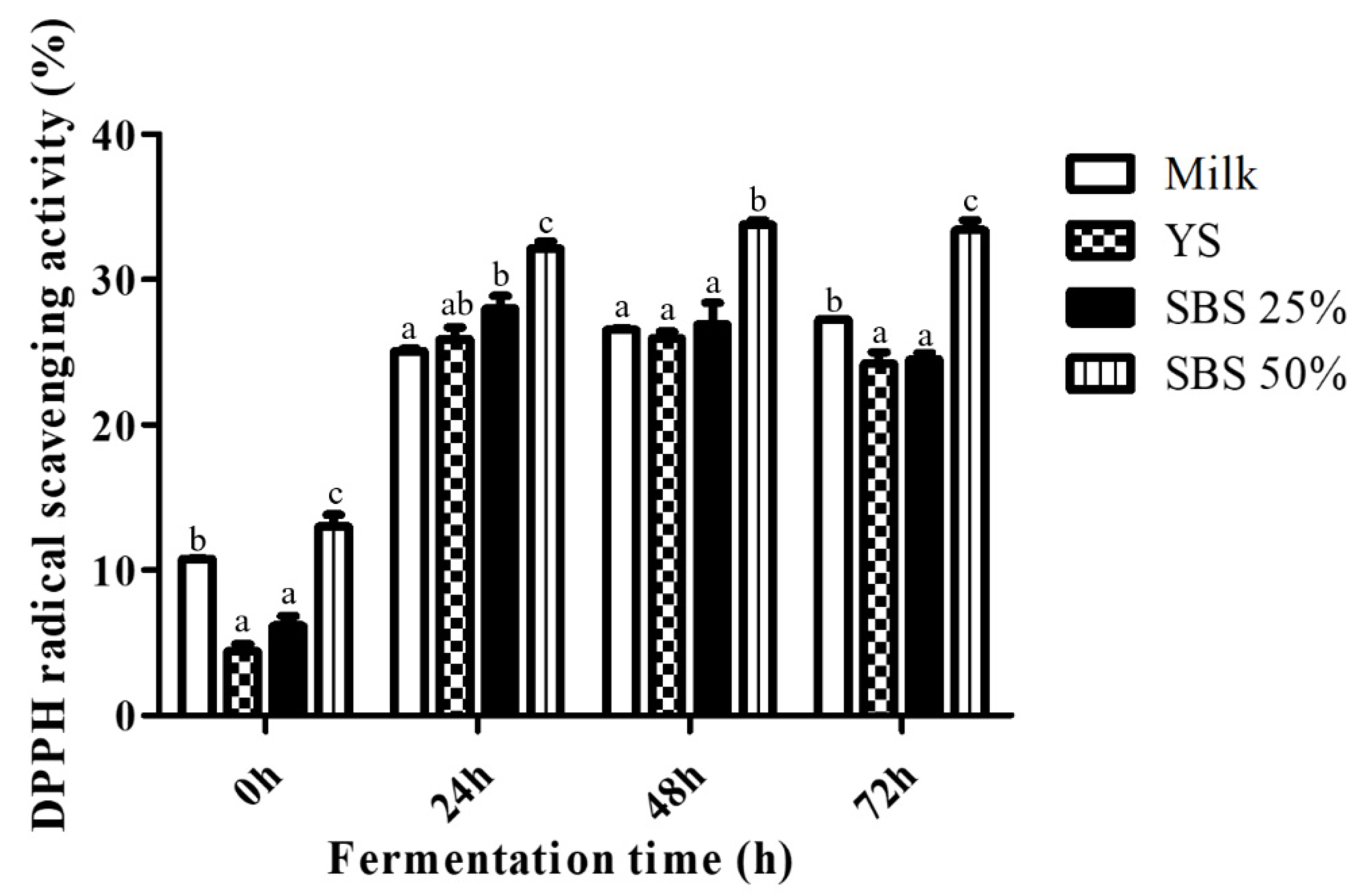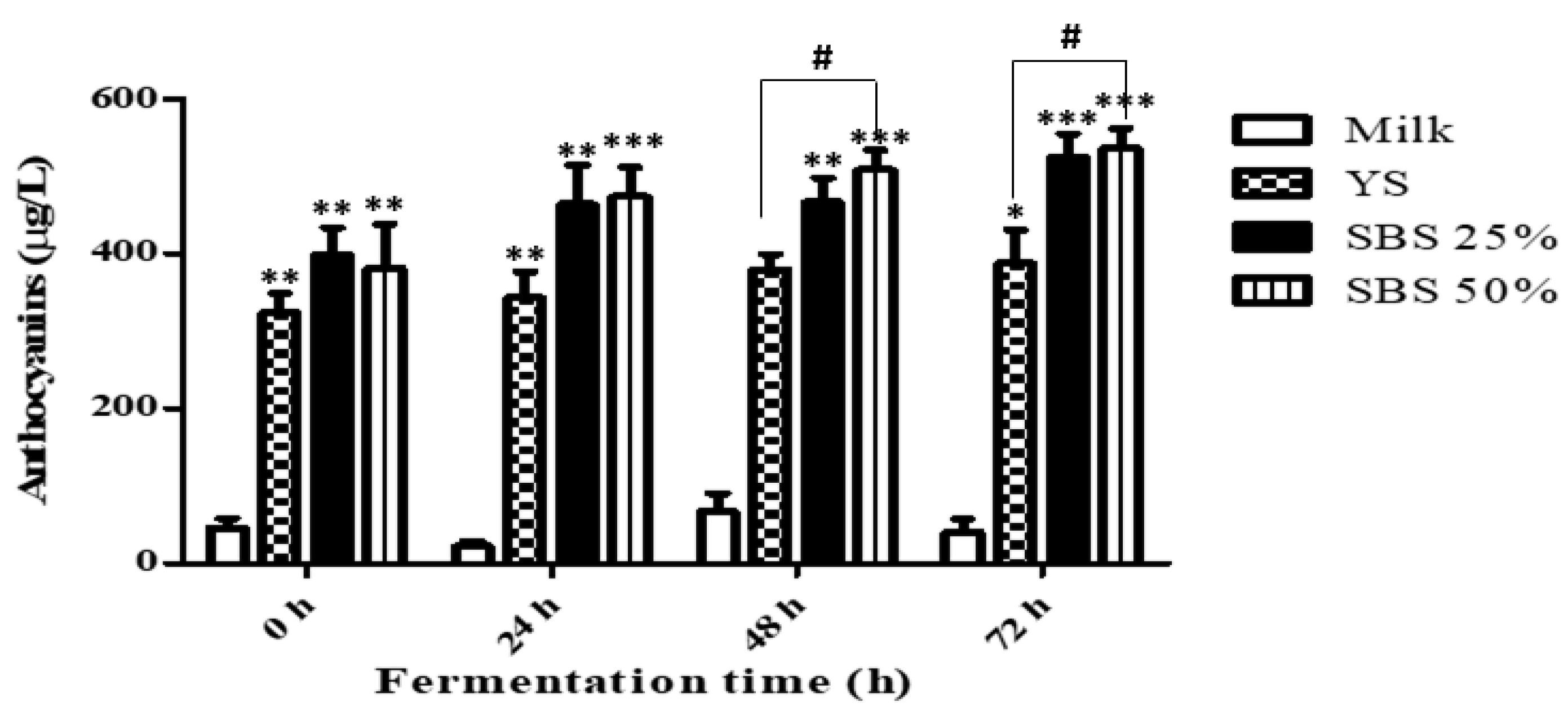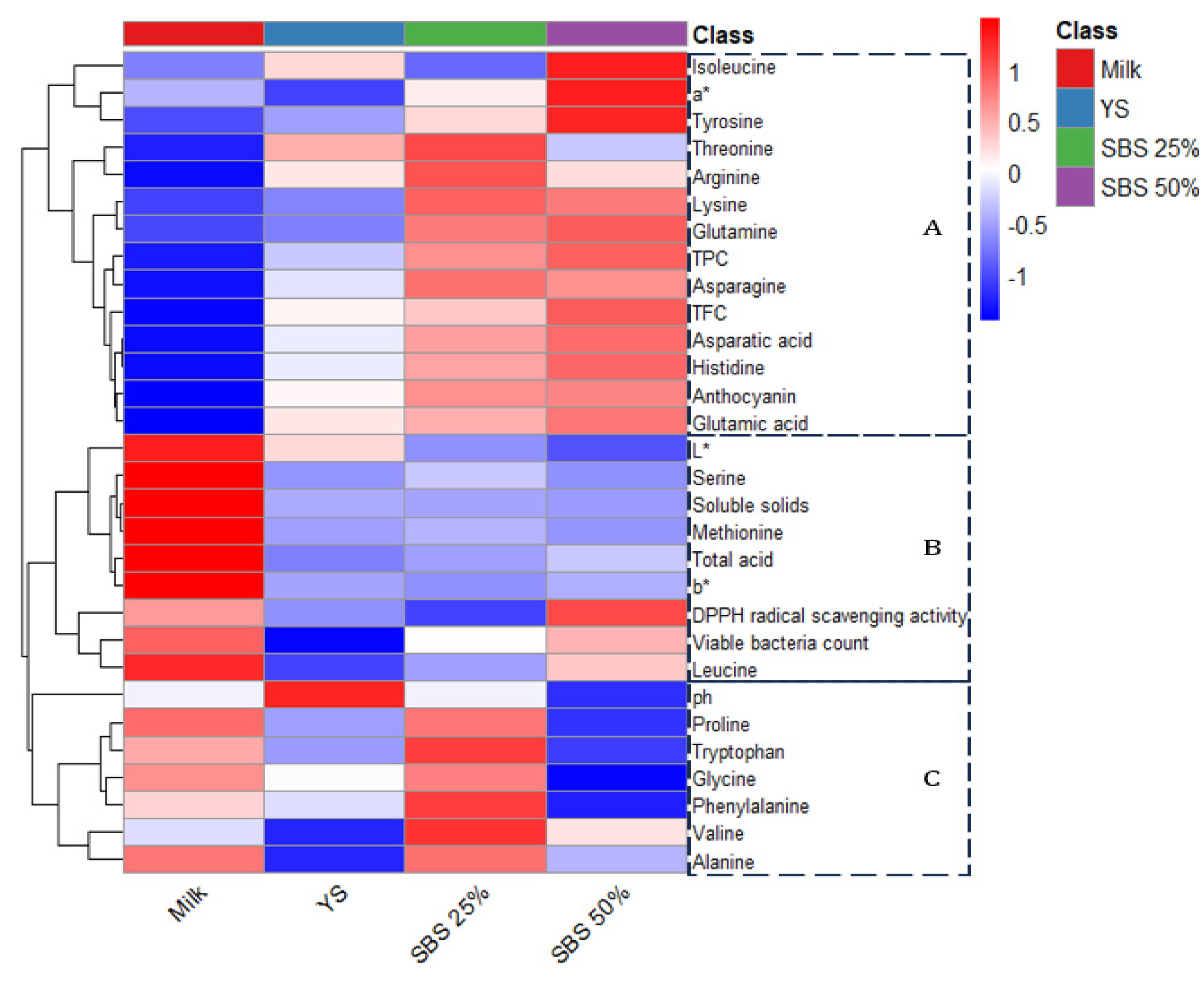Fermentation and Bioactivity Properties in Small Black Soybean (Seomoktae)-Enriched Fermented Soymilk
Abstract
1. Introduction
2. Materials and Methods
2.1. Sample Preparation
2.2. Physicochemical Properties
2.3. Viable Bacterial Count Measurement
2.4. Antioxidant Activity Measurement
2.5. Total Anthocyanin Content (TAC) Analysis
2.6. Digestive Model Based on Enzyme Treatment
2.7. Free Amino Acid Analysis
2.8. Heatmap Analysis
2.9. Statistical Analysis
3. Results
3.1. Fermentation Characteristics
3.2. Viable Bacterial Count
3.3. Sample Extract Antioxidant Activity
3.4. Total Anthocyanin Content (TAC)
3.5. Free Amino Acid Conversion by the INFOGEST Experiment
3.6. Heatmap Analysis
4. Discussion
5. Conclusions
6. Patents
Author Contributions
Funding
Institutional Review Board Statement
Informed Consent Statement
Data Availability Statement
Acknowledgments
Conflicts of Interest
References
- Leroy, F.; De Vuyst, L. Lactic Acid Bacteria as Functional Starter Cultures for the Food Fermentation Industry. Trends Food Sci. Technol. 2004, 15, 67–78. [Google Scholar] [CrossRef]
- Seo, J.-H.; Lee, H. Characteristics and Immunomodulating Activity of Lactic Acid Bacteria for the Potential Probiotics. Korean J. Food Sci. Technol. 2007, 39, 681–687. [Google Scholar]
- Zapaśnik, A.; Sokołowska, B.; Bryła, M. Role of Lactic Acid Bacteria in Food Preservation and Safety. Foods 2022, 11, 1283. [Google Scholar] [CrossRef]
- Grasso, N.; Alonso-Miravalles, L.; O’Mahony, J.A. Composition, Physicochemical and Sensorial Properties of Commercial Plant-Based Yogurts. Foods 2020, 9, 252. [Google Scholar] [CrossRef] [PubMed]
- Munekata, P.E.S.; Domínguez, R.; Budaraju, S.; Roselló-Soto, E.; Barba, F.J.; Mallikarjunan, K.; Roohinejad, S.; Lorenzo, J.M. Effect of Innovative Food Processing Technologies on the Physicochemical and Nutritional Properties and Quality of Non-dairy Plant-Based Beverages. Foods 2020, 9, 288. [Google Scholar] [CrossRef]
- Shin, J.-S.; Kim, B.-H.; Kim, H.-S.; Baik, M.-Y. Optimization of Pea Protein and Citrus Fiber Contents for Plant Based Stirred Soymilk Yogurt Using Response Surface Methodology. Food Sci. Biotechnol. 2022, 31, 1691–1701. [Google Scholar] [CrossRef]
- Granato, D.; Branco, G.F.; Nazzaro, F.; Cruz, A.G.; Faria, J.A.F. Functional Foods and Nondairy Probiotic Food Development: Trends, Concepts, and Products. Compr. Rev. Food Sci. Food Saf. 2010, 9, 292–302. [Google Scholar] [CrossRef]
- Oh, J.; Park, C.; Ahn, D.; Byun, J.; Jung, S.P. Veganomics: Current Status and Challenges. J. Korean Soc. Environ. Eng. 2023, 45, 296–310. [Google Scholar] [CrossRef]
- Fassio, F.; Facioni, M.S.; Guagnini, F. Lactose maldigestion, malabsorption, and intolerance: A comprehensive review with a focus on current management and future perspectives. Nutrients 2018, 10, 1599. [Google Scholar] [CrossRef]
- Kim, M.J.; Ha, B.J. Antihyperglycemic and Antihyperlipidemic Effects of Fermented Rhynchosia nulubilis in Alloxan-Induced Diabetic Rats. Toxicol. Res. 2013, 29, 15–19. [Google Scholar] [CrossRef] [PubMed]
- Kim, A.-J. The Inhibitory Effects of Roasted Black Bean (Rhynchosia nulubilis) Extracts on RANKL-Mediated RAW264. 7 Cells Differentiation. Food Sci. Biotechnol. 2016, 25, 839–846. [Google Scholar] [CrossRef] [PubMed]
- Sung, H.-Y.; Kim, K.H. Hair Growth Promotion with Black Soybean Extracts: Case Series. J. Pharmacopuncture 2022, 25, 63–67. [Google Scholar] [CrossRef]
- Park, H.; Yu, S.; Kim, W. Amelioration of Aging-Induced Muscular Decline by Black Soybean (Rhynchosia nulubilis) and Black Rice (Oryza sativa L.) Extracts. Front. Immunol. 2025, 16, 1554941. [Google Scholar] [CrossRef]
- Leksono, B.Y.; Cahyanto, M.N.; Rahayu, E.S.; Yanti, R.; Utami, T. Enhancement of antioxidant activities in black soy milk through isoflavone aglycone production during indigenous lactic acid bacteria fermentation. Fermentation 2022, 8, 326. [Google Scholar] [CrossRef]
- Cheng, K.-C.; Lin, J.-T.; Liu, W.-H. Extracts from fermented black soybean milk exhibit antioxidant and cytotoxic activities. Food Technol. Biotechnol. 2011, 49, 111–117. [Google Scholar]
- Sim, E.A.; Kim, S.-Y.; Kim, S.; Mun, E.-G. Probiotic Potential and Enhanced Adhesion of Fermented Foods-Isolated Lactic Acid Bacteria to Intestinal Epithelial Caco-2 and HT-29 Cells. Microorganisms 2024, 13, 32. [Google Scholar] [CrossRef]
- Sembiring, E.N.; Elya, B.; Sauriasari, R. Phytochemical Screening, Total Flavonoid and Total Phenolic Content and Antioxidant Activity of Different Parts of Caesalpinia bonduc (L.) Roxb. Pharmacogn. J. 2017, 10, 123–127. [Google Scholar] [CrossRef]
- Brodkorb, A.; Egger, L.; Alminger, M.; Alvito, P.; Assunção, R.; Ballance, S.; Bohn, T.; Bourlieu-Lacanal, C.; Boutrou, R.; Carrière, F.; et al. INFOGEST Static In Vitro Simulation of Gastrointestinal Food Digestion. Nat. Protoc. 2019, 14, 991–1014. [Google Scholar] [CrossRef] [PubMed]
- Lee, S.W.; Kwon, J.H.; Yoon, S.R.; Woo, S.M.; Jang, S.Y.; Yeo, S.H.; Choi, J.H.; Jeong, Y.J. Quality Characteristics of Brown Rice Vinegar by Different Yeasts and Fermentation Condition. J. Korean Soc. Food Sci. Nutr. 2010, 39, 1366–1372. [Google Scholar] [CrossRef]
- Farinde, E.O.; Adesetan, T.O.; Obatolu, V.A.; Oladapo, M.O. Chemical and Microbial Properties of Yogurt Processed from Cow’s Milk and Soymilk. J. Food Process. Preserv. 2009, 33, 245–254. [Google Scholar] [CrossRef]
- Shin, Y.S.; Sung, H.J.; Kim, D.H.; Lee, K.S. Preparation of Yogurt Added with Potato and Its Characteristics. Korean J. Food Sci. Technol. 1994, 26, 266–271. [Google Scholar]
- Lim, Y.; Hong, S.; Shin, Y.K.; Kang, S.H. Changes in the Viability of Lactic Acid Bacteria During Storage of Freeze-Dried Yogurt Snacks. J. Dairy Sci. Biotechnol. 2015, 33, 203–207. [Google Scholar]
- KFDA. Food Code; Ministry of Food and Drug Safety: Cheongju, Republic of Korea, 2021; Available online: https://various.foodsafetykorea.go.kr/fsd/#/ext/Document/FC (accessed on 26 August 2025).
- Vanga, S.K.; Raghavan, V. How Well Do Plant Based Alternatives Fare Nutritionally Compared to Cow’s Milk? J. Food Sci. Technol. 2018, 55, 10–20. [Google Scholar] [CrossRef] [PubMed]
- Marazza, J.A.; Nazareno, M.A.; de Giori, G.S.; Garro, M.S. Enhancement of the Antioxidant Capacity of Soymilk by Fermentation with Lactobacillus rhamnosus. J. Funct. Foods. 2012, 4, 594–601. [Google Scholar] [CrossRef]
- Tonolo, F.; Moretto, L.; Folda, A.; Scalcon, V.; Bindoli, A.; Bellamio, M.; Feller, E.; Rigobello, M.P. Antioxidant Properties of Fermented Soy During Shelf Life. Plant Foods Hum. Nutr. 2019, 74, 287–292. [Google Scholar] [CrossRef]
- Hong, J.Y.; Shin, S.R.; Kong, H.J.; Choi, E.M.; Woo, S.C.; Lee, M.H.; Yang, K.M. Antioxidant Activity of Extracts from Soybean and Small Black Bean. Food Sci. Preserv. 2014, 21, 404–411. [Google Scholar]
- Lodha, D.; Das, S.; Hati, S. Antioxidant Activity, Total Phenolic Content and Biotransformation of Isoflavones During Soy Lactic-Fermentations. J. Food Process. Preserv. 2021, 45, e15583. [Google Scholar] [CrossRef]
- Sun, Y.; Xu, J.; Zhao, H.; Li, Y.; Zhang, H.; Yang, B.; Guo, S. Antioxidant Properties of Fermented Soymilk and Its Anti-Inflammatory Effect on DSS-Induced Colitis in Mice. Front. Nutr. 2022, 9, 1088949. [Google Scholar] [CrossRef]
- Meenakshi, S.; Gnanambigai, D.M.; Mozhi, S.T.; Arumugam, M.; Balasubramanian, T. Total Flavanoid and In Vitro Antioxidant Activity of Two Seaweeds of Rameshwaram Coast. Glob. J. Pharmacol. 2009, 3, 59–62. [Google Scholar]
- Turturică, M.; Oancea, A.M.; Râpeanu, G.; Bahrim, G. Anthocyanins: Naturally Occurring Fruit Pigments with Functional Properties. Ann. Univ. Dunarea Jos Galati Fascicle VI Food Technol. 2015, 39, 9–24. [Google Scholar]
- Bąkowska-Barczak, A. Acylated Anthocyanins as Stable, Natural Food Colorants-A Review. Pol. J. Food Nutr. Sci. 2005, 14, 107–116. [Google Scholar]
- Sa, J.H.; Shin, I.C.; Jeong, K.J.; Shim, T.H.; Oh, H.S.; Kim, Y.J.; Cheung, E.H.; Kim, G.G.; Choi, D.S. Antioxidative Activity and Chemical Characteristics from Different Organs of Small Black Soybean (Yak-Kong) Grown in the Area of Jungsun. Korean J. Food Sci. Technol. 2003, 35, 309–315. [Google Scholar]
- Jeong, I.-H.; Oh, M.-S.; Jeon, J.-S.; Kim, H.-T.; Hong, S.-R.; Park, K.-H.; Yoon, M.-H. A Comparative Study on Anthocyanin and Polyphenol Contents in Colored Agricultural Products. J. Food Hyg. Saf. 2017, 32, 371–380. [Google Scholar] [CrossRef]
- Liang, Z.; Huang, Y.; Zhang, P.; Fang, Z. Impact of fermentation on the structure and antioxidant activity of selective phenolic compounds. Food Biosci. 2023, 56, 103147. [Google Scholar] [CrossRef]
- Wu, Y.; Huang, Y.; Yu, J.; Wang, F.; Li, X.; Liu, Y.; Ma, X. Changes of proteins and amino acids in soymilk during lactic acid fermentation and subsequent storage. J. Food Meas. Charact. 2022, 16, 4728–4737. [Google Scholar] [CrossRef]
- Ren, Y.; Li, L. The influence of protease hydrolysis of lactic acid bacteria on the fermentation induced soybean protein gel: Protein molecule, peptides and amino acids. Food Res. Int. 2022, 156, 111284. [Google Scholar] [CrossRef]
- Yan, H.; Jin, J.Q.; Yang, P.; Yu, B.; He, J.; Mao, X.B.; Yu, J.; Chen, D.W. Fermented soybean meal increases nutrient digestibility via the improvement of intestinal function, anti-oxidative capacity and immune function of weaned pigs. Animal 2022, 16, 100557. [Google Scholar] [CrossRef]
- Juan, M.-Y.; Chou, C.C. Enhancement of antioxidant activity, total phenolic and flavonoid content of black soybeans by solid state fermentation with Bacillus subtilis BCRC 14715. Food Microbiol. 2010, 27, 586–591. [Google Scholar] [CrossRef] [PubMed]
- Sim, E.A.; Mun, E.-G.; Oh, B.-J.; Jeong, S.-I. Fermentation Characteristics of Cheonggukjang Prepared from Non-germinated Pungsannamul-Soybeans. JKFN 2024, 53, 70–78. [Google Scholar] [CrossRef]




| Fermentation Time (h) | Sample | |||
|---|---|---|---|---|
| Milk | YS 1 | SBS 25% | SBS 50% | |
| 0 | 0.00 ± 0.00 A2 | 0.00 ± 0.00 A | 0.00 ± 0.00 A | 0.00 ± 0.00 A |
| 12 | 11.09 ± 0.35 Cb | 9.22 ± 0.02 Ba | 9.33 ± 0.01 Ba | 9.30 ± 0.05 Ba |
| 24 | 12.56 ± 0.43 Db | 9.90 ± 0.25 Ca | 9.94 ± 0.28 Ca | 10.04 ± 0.05 DEa |
| 36 | 12.52 ± 0.19 Db | 9.64 ± 0.01 Ca | 10.07 ± 0.07 Ca | 9.71 ± 0.31 Ca |
| 48 | 11.22 ± 0.02 Cb | 9.89 ± 0.11 Ca | 10.05 ± 0.05 Ca | 10.04 ± 0.01 DEa |
| 60 | 9.96 ± 0.47 B | 10.21 ± 0.14 D | 9.89 ± 0.23 C | 10.14 ± 0.09 E |
| 72 | 9.88 ± 0.00 Bb | 9.34 ± 0.06 Ba | 9.68 ± 0.25 BCab | 9.77 ± 0.10 CDb |
| Antioxidant Activity | Fermentation Time (h) | Sample | |||
|---|---|---|---|---|---|
| Milk | YS 1 | SBS 25% | SBS 50% | ||
| TPC 2 (µg GAE/g) | 0 | 44.52 ± 1.06 Aba45 | 89.46 ± 0.04 Bb | 86.26 ± 12.15 b | 108.59 ± 6.15 Bc |
| 24 | 39.06 ± 3.41 Aa | 74.48 ± 7.76 Ab | 80.70 ± 3.62 b | 87.45 ± 3.76 Ab | |
| 48 | 43.74 ± 2.08 ABa | 69.52 ± 2.79 Ab | 76.62 ± 2.39 b | 84.53 ± 6.98 Ac | |
| 72 | 46.02 ± 0.45 Ba | 67.74 ± 3.49 Ab | 89.08 ± 10.95 c | 94.52 ± 1.78 ABc | |
| TFC 3 (µg QE/g) | 0 | 2.17 ± 1.42 a | 5.65 ± 1.39 b | 5.32 ± 0.31 ab | 7.14 ± 1.57 b |
| 24 | 1.32 ± 0.08 a | 6.61 ± 0.28 b | 7.64 ± 2.86 b | 7.66 ± 1.11 b | |
| 48 | 2.00 ± 0.90 a | 6.59 ± 0.54 b | 7.48 ± 1.41 b | 8.12 ± 1.07 b | |
| 72 | 2.29 ± 0.27 a | 7.06 ± 0.01 b | 7.83 ± 0.93 b | 9.83 ± 0.29 c | |
| Free Amino Acid | Before Enzyme Treatment (nmol/mL) | After Enzyme Treatment (nmol/mL) [Digestibility 2 (%)] | |||||||
|---|---|---|---|---|---|---|---|---|---|
| Milk | YS 1 | SBS 25% | SBS 50% | Milk | YS | SBS 25% | SBS 50% | ||
| Essential amino acid | Leu | 244.0 | 41.8 | 41.9 | 42.0 | 11,762.8 [97.9] | 7261.7 [99.4] | 8272.6 [99.5] | 9965.4 [99.6] |
| Ile | 51.4 | 27.9 | 27.9 | 28.0 | 1078.7 [95.2] | 1184.7 [97.6] | 1062.0 [97.49] | 1303.5 [97.8] | |
| Val | 102.7 | 13.9 | 14.0 | 14.0 | 821.9 [87.5] | 766.6 [98.2] | 894.3 [98.4] | 841.0 [98.3] | |
| Thr | 128.4 | 0.0 | 0.0 | 0.0 | 359.6 [46.9] | 334.5 [81.0] | 363.3 [70.0] | 280.3 [80.8] | |
| Lys | 89.9 | 111.5 | 125.8 | 112.1 | 3082.0 [63.6] | 2773.7 [58.2] | 3088.3 [73.0] | 2901.3 [77.6] | |
| Met | 38.5 | 27.9 | 27.9 | 28.0 | 1104.4 [77.8] | 446.0 [95.5] | 545.0 [91.3] | 434.5 [95.8] | |
| Phe | 115.6 | 69.7 | 69.9 | 70.1 | 3608.5 [100.0] | 3498.4 [100.0] | 3605.3 [100.0] | 3447.9 [100.0] | |
| Trp | 51.4 | 27.9 | 27.9 | 28.0 | 642.1 [64.3] | 850.2 [100.0] | 922.3 [100.0] | 756.9 [100.0] | |
| His | 89.9 | 111.5 | 139.7 | 126.1 | 218.3 [100.0] | 306.6 [100.0] | 377.3 [89.3] | 364.4 [87.1] | |
| Arg | 166.9 | 515.7 | 1145.9 | 1471.7 | 3531.4 [52.4] | 5603.1 [78.9] | 6623.7 [80.0] | 7064.1 [77.8] | |
| Optimal essential amino acid | Gly | 436.6 | 167.3 | 335.4 | 210.2 | 821.9 [97.1] | 878.1 [96.0] | 1117.9 [95.9] | 1093.2 [96.1] |
| Ala | 256.8 | 320.6 | 279.5 | 238.3 | 706.3 [97.8] | 766.6 [97.2] | 1034.1 [98.9] | 1065.2 [98.6] | |
| Non essential amino acid | Ser | 51.4 | 13.9 | 27.9 | 14.0 | 231.1 [59.6] | 306.6 [100.0] | 321.4 [100.0] | 336.4 [100.0] |
| Pro | 475.1 | 0.0 | 0.0 | 0.0 | 475.1 [96.5] | 27.9 [93.8] | 55.9 [94.9] | 14.0 [93.5] | |
| Asn | 0.0 | 0.0 | 41.9 | 56.1 | 166.9 [58.8] | 320.6 [63.6] | 391.3 [63.0] | 434.5 [65.4] | |
| Asp | 128.4 | 55.8 | 55.9 | 56.1 | 269.7 [96.8] | 264.8 [98.0] | 279.5 [98.1] | 252.3 [98.0] | |
| Gln | 12.8 | 27.9 | 14.0 | 14.0 | 577.9 [95.3] | 989.6 [90.8] | 1215.7 [82.7] | 1009.2 [79.2] | |
| Glu | 244.0 | 0.0 | 0.0 | 0.0 | 603.6 [96.7] | 655.1 [96.3] | 740.6 [97.2] | 855.0 [95.8] | |
| Tyr | 89.9 | 83.6 | 83.8 | 84.1 | 2735.2 [92.0] | 2258.0 [96.7] | 3004.4 [97.0] | 2018.3 [96.3] | |
| Total | 2773.8 | 1616.8 | 2459.4 | 2593.0 | 32,797.2 | 29,492.8 | 33,914.9 | 34,437.3 | |
Disclaimer/Publisher’s Note: The statements, opinions and data contained in all publications are solely those of the individual author(s) and contributor(s) and not of MDPI and/or the editor(s). MDPI and/or the editor(s) disclaim responsibility for any injury to people or property resulting from any ideas, methods, instructions or products referred to in the content. |
© 2025 by the authors. Licensee MDPI, Basel, Switzerland. This article is an open access article distributed under the terms and conditions of the Creative Commons Attribution (CC BY) license (https://creativecommons.org/licenses/by/4.0/).
Share and Cite
Sim, E.A.; Kim, H.; Kim, S.-Y.; Mun, E.-G. Fermentation and Bioactivity Properties in Small Black Soybean (Seomoktae)-Enriched Fermented Soymilk. Fermentation 2025, 11, 655. https://doi.org/10.3390/fermentation11120655
Sim EA, Kim H, Kim S-Y, Mun E-G. Fermentation and Bioactivity Properties in Small Black Soybean (Seomoktae)-Enriched Fermented Soymilk. Fermentation. 2025; 11(12):655. https://doi.org/10.3390/fermentation11120655
Chicago/Turabian StyleSim, Eun Ah, Hyeonbin Kim, Seon-Young Kim, and Eun-Gyung Mun. 2025. "Fermentation and Bioactivity Properties in Small Black Soybean (Seomoktae)-Enriched Fermented Soymilk" Fermentation 11, no. 12: 655. https://doi.org/10.3390/fermentation11120655
APA StyleSim, E. A., Kim, H., Kim, S.-Y., & Mun, E.-G. (2025). Fermentation and Bioactivity Properties in Small Black Soybean (Seomoktae)-Enriched Fermented Soymilk. Fermentation, 11(12), 655. https://doi.org/10.3390/fermentation11120655






